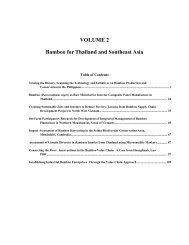WBC-VIII-Vol.4 – Resources – Forestry, Plantations and ... - BambuSC
WBC-VIII-Vol.4 – Resources – Forestry, Plantations and ... - BambuSC
WBC-VIII-Vol.4 – Resources – Forestry, Plantations and ... - BambuSC
You also want an ePaper? Increase the reach of your titles
YUMPU automatically turns print PDFs into web optimized ePapers that Google loves.
Seeds<br />
Availability of seed is limited to certain specific periods only as bamboos flower only once in life time. Most of<br />
the bamboo flower in long cycles ranging from 10 years to over 60 years depending upon the species. Usually<br />
the cyclic flowering is gregarious <strong>and</strong> after flowering, the entire flowered bamboo population dies. The huge<br />
quantity of seed produced are either washed out in hill slopes during rains, or eaten by rodents (rats). The<br />
remaining seeds fallen in ideal conditions germinate to seedlings for regeneration.<br />
Rhizome Planting<br />
This is the most common propagation method of bamboo. The bulky rhizomes of bamboos are dug out in the<br />
rainy season <strong>and</strong> planted in the field. The use of rhizomes for propagating bamboo has been limited to nonclump<br />
forming species. However, following are some limitations of rhizome planting:<br />
- Not easy to transport<br />
- Meagre development of roots<br />
- Decay of rhizomes <strong>and</strong><br />
- Slowness of rhizomes buds to break dormancy.<br />
Off-set Planting<br />
The term off-set is described for bamboo propagules each composed of the lower part of a single culm with the<br />
rhizome axis basal to it. The age of off-set should not be more than 2 years at the time of planting for better<br />
results. Propagation of bamboos by off-set planting is very common method in villages of Assam. Both age of<br />
the off-sets <strong>and</strong> their collection time have significant effect on their survival <strong>and</strong> growth after field plantation<br />
(Banik 1991). More success is obtained when off-sets are collected <strong>and</strong> planted in the month of April before<br />
rainy season. Two nodes of the culm with rhizome are sufficient for better survival of the off-sets in field. These<br />
should be planted immediately after the excavation from mother clump <strong>and</strong> should be kept in moist gunny bags<br />
during transport.<br />
Culm or Stem Cutting<br />
Propagation of bamboo through culm or stem segments is known as culm cutting or stem cutting technique.<br />
Generally culm segment of bamboos of 1 or 2-3 nodes bearing healthy buds or branches used for propagation.<br />
Culm cutting should be taken from 1.5-2 years old healthy mother culms during February- April. The thin<br />
walled top one third portions of the segments should be discarded for better results. Rest of the culm is used to<br />
make either single nodded or two-noded cuttings depending on species (two- nodded in Bambusa tulda, B.<br />
nutans,, Dendrocalamus hamiltonii <strong>and</strong> one nodded in Bambusa balcooa). The clums are cut in such a way that<br />
about 5 cm culm length is retained on either side of the node/nodes. The leafy branch lets are trimmed to about<br />
five cm length. Cuttings with dried <strong>and</strong> damaged buds must be discarded. After 200 ppm IBA treatment,<br />
cuttings will be planted in raised beds under partial shade (Pathak et al. 2008).<br />
<strong>VIII</strong> World Bamboo Congress Proceedings Vol 4-20




